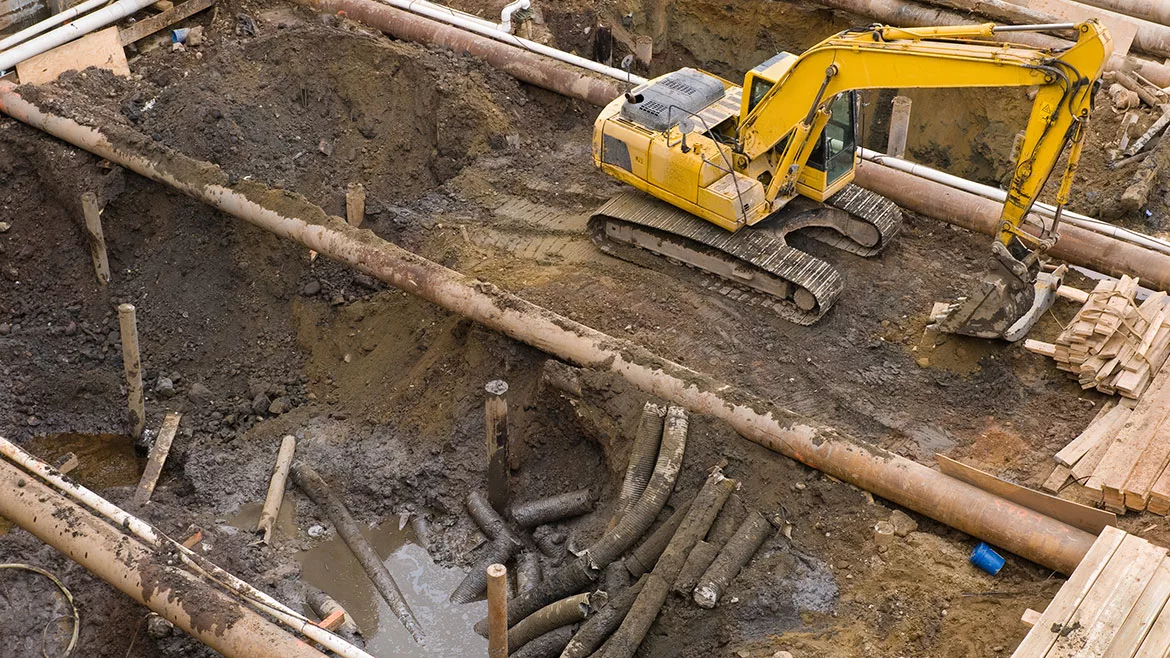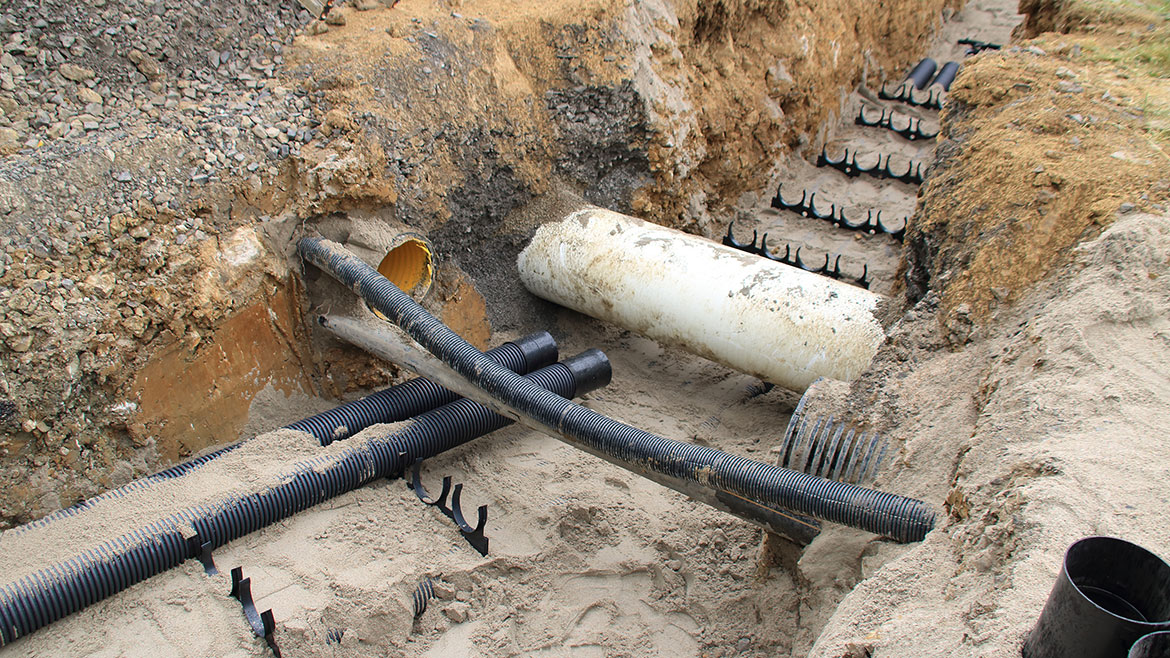4 Reasons to consider trenchless technologies
Trenchless technology offers a less disruptive, faster and more sustainable way to replace and rehabilitate aging infrastructure.

Traditional excavation requires not only labor and materials for the new pipe, but also costs related to road repairs, landscaping restoration and project delays. Image courtesy of shayes17 / E+ / Getty Images
The state of our underground sanitary drainage infrastructure plays a crucial role in maintaining the safety, health and functionality of our communities. Aging and damaged building sewer and drainage piping poses significant challenges for cities worldwide. The traditional method of pipe replacement, which involves digging up roads and landscaping, often causes environmental damage and costly disruptions to daily life.
That’s where trenchless technology comes into play – a game-changing approach to pipe replacement and rehabilitation that provides less disruption, greater speed and lower costs.
What is trenchless technology?
Trenchless technology refers to a set of methods used to install, replace or repair pipes without the need for large-scale excavation. The two most common trenchless techniques are pipe replacement and pipe lining, each designed to address specific challenges in underground infrastructure.
Trenchless pipe replacement involves inserting a new pipe into an existing, damaged one through a process called pipe bursting. A specialized bursting head is pushed through the old pipe, breaking it apart while simultaneously pulling in the new pipe. This allows for complete replacement without disturbing the surface above, minimizing the need for digging.
Pipe lining, on the other hand, is used to rehabilitate damaged pipes without replacing them entirely. A flexible liner, typically made of resin-coated felt, is inserted into the existing pipe and then inflated, adhering to the inner walls of the pipe. The resin hardens, effectively creating a new pipe within the old one. This technique is ideal for repairing pipes with minor cracks or deterioration.
Trenchless technology in the international codes
Both trenchless techniques are recognized within the International Code Council’s International Plumbing Code® (IPC) and the International Residential Code® (IRC) to address failing building sewer and drainage piping.
Currently, pipe replacement by pipe bursting methods is referenced in Section 716 of the IPC and Section P3010 of the IRC, with relining of building sewers and drains referenced in Section 717 of the IPC and Section 3011 of the IRC.
The code allows for pipe bursting to be used to replace pipes that are a maximum of six inches (152 mm) and smaller. Replacement piping must be of the same nominal size as the existing piping, which must be inspected internally with a recorded video camera survey ahead of replacement. Per the code, the survey must include notations of the position of the cleanouts and the depth of the connections to the existing piping.
Prior to relining, piping sections must be descaled and cleaned, then flushed with water and inspected internally using a recorded video camera survey. This allows the installer to determine if the piping can be relined. There are times when the degradation is so severe that the pipe must be entirely replaced by traditional methods.

As our communities continue to grow and modernize, trenchless methods will play a key role in building sustainable, resilient cities for the future. Image courtesy of HorstBingemer / iStock / Getty Images Plus
After the installation has been completed, the relined piping system must be flushed and flow-tested with water and then inspected internally with a recorded video camera survey.
These innovative techniques not only preserve the aesthetic and structural integrity of neighborhoods, but also offer a variety of environmental, economic and practical benefits.
The benefits of trenchless technology
1. Minimal environmental disruption
Trenchless pipe replacement and pipelining technologies have multiple benefits, making them a compelling choice for municipalities and homeowners alike. One of the obvious benefits of trenchless methods is the minimal disruption they cause to the surrounding environment.
Traditional pipe replacement often requires extensive excavation, disrupting roads, sidewalks, landscaping and even businesses. Trenchless technology allows for repairs and replacements to be carried out with minimal surface disturbance, preserving the integrity of streets and public spaces. For residents and business owners, this means less noise, fewer traffic detours and reduced construction-related delays.
Compared to large-scale excavation, trenchless methods reduce soil erosion, water runoff and damage to nearby vegetation by avoiding extensive digging. By preserving the natural environment, these methods help to maintain local ecosystems – ideal for sensitive or protected areas.
Both pipe replacement and pipelining extend the lifespan of underground infrastructure. Trenchless pipe replacement uses materials that are highly resistant to corrosion, such as HDPE (high-density polyethylene), which significantly increases the durability of the new pipe.
Similarly, pipelining provides an additional protective layer that strengthens the existing pipe, preventing leaks and minimizing the risk of further deterioration. These long-lasting solutions not only reduce the need for frequent repairs but also improve the overall safety and efficiency of the pipeline system.
2. Identifying and mitigating infrastructure failures
In older pipelines, issues such as leaks, blockages and deterioration can pose significant risks to public safety. For example, a cracked sewer line can lead to sewage backups, water contamination and environmental hazards. This problem is quite significant – any crack, even a small one, could allow groundwater to leak into a sanitary sewage system. Groundwater can't be separated from the water already in the sanitary system and will ultimately end up in a wastewater treatment facility, where extra resources (including chemicals) will be used to treat the excess water.
Per the Environmental Protection Agency (EPA), the expenses associated with wastewater collection and treatment range from $2 to $5 per thousand gallons. Thus, an annual infiltration and inflow (I&I) volume of 150 million gallons would cost between $300,000 and $750,000.
Treatment facilities may be bogged down and may even leak untreated water into clean water sources, if the water infiltration exceeds the capacity of a treatment facility. There is an added cost as well – one report estimated that the state of Tennessee spends $188 million annually to process extra water that comes into its sanitary systems.
By utilizing trenchless technology, municipalities can repair their aging and ailing underground infrastructure and reduce or even eliminate these unnecessary expenses. Trenchless technology allows for rapid identification and rehabilitation of problematic areas, reducing the risk of system failures and the associated risks to the environment and human health.
3. Projects move faster
Another significant benefit of trenchless technology is the speed at which projects can be completed. While traditional excavation projects can take weeks or even months, trenchless methods often take just a fraction of that time. Less digging means quicker restoration of services and fewer disruptions to the daily lives of residents.
This is particularly beneficial in urban areas where downtime or construction noise can severely impact businesses and traffic flow. Trenchless methods offer a much faster turnaround, helping to avoid lengthy construction delays and providing immediate benefits to the community.
4. Long-term cost savings over traditional methods
While the upfront cost of trenchless pipe replacement or pipe lining may be slightly higher than traditional methods, the long-term savings are substantial. Traditional excavation requires not only labor and materials for the new pipe, but also costs related to road repairs, landscaping restoration and project delays. Trenchless methods significantly reduce these ancillary expenses. The ability to complete projects quickly, and with minimal surface disruption, also leads to fewer hidden costs and shorter construction timelines.
Traditional pipe replacement often requires extensive excavation, disrupting roads, sidewalks, landscaping and even businesses. Trenchless technology allows for repairs and replacements to be carried out with minimal surface disturbance, preserving the integrity of streets and public spaces.
Trenchless technology may also help to ensure that our underground sanitary drainage infrastructure is maintained even if the current labor shortage in the plumbing industry continues to worsen. As more professionals age out of the field and enter retirement, the number of unfilled vacancies is expected to increase. Trenchless technology requires fewer workers than a traditional method involving open excavation replacement and installation.
An innovative solution for resilient cities
Trenchless pipe replacement and pipelining technologies are transforming the way we manage underground sanitary drainage systems. These advanced techniques provide communities with a cost-effective, environmentally friendly and less disruptive solution to aging and deteriorating pipes.
As our communities continue to grow and modernize, trenchless methods will play a key role in building sustainable, resilient cities for the future.
Learn more about trenchless pipe replacement and pipe lining technologies, here.
Looking for a reprint of this article?
From high-res PDFs to custom plaques, order your copy today!





